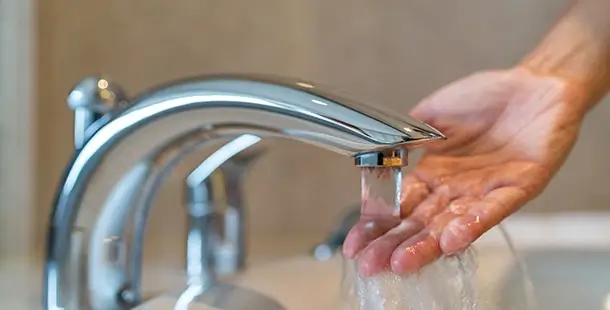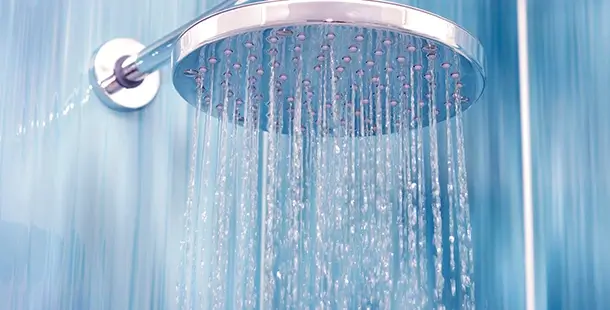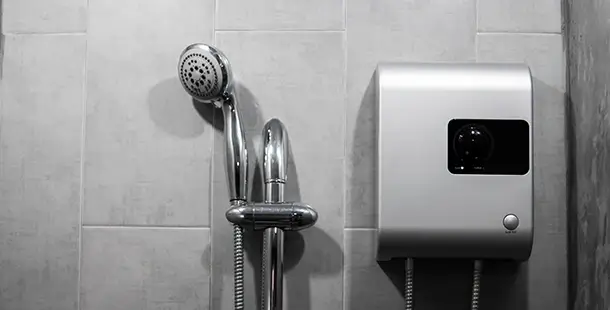Hot Water Recirculation Systems
In your Orange County home, hot water may pass through 80 feet of piping from your water heater to the shower nozzle. More than 3 gallons of cold water goes down the drain while you wait for hot water to arrive.
When you turn off the shower, more than 3 gallons of hot water remains in the line unused. It cools off and is wasted the next time you run the hot water again.
If you think there should be a more efficient setup, there is. It’s a hot water recirculating system, and it’s surprisingly easy to implement.

What Is Hot Water Recirculation?
Hot water recirculation moves water in a continuous loop. Cooled and unused water returns to the water heater; hot water remains close to the point of use, arriving almost instantaneously at the tap or shower. Recirculation eliminates wasted water, energy, and time.
Active Hot Water Recirculation
Active recirculating systems use a pump and timer to push hot water to every hot water fixture. The pump is installed on the hot water outlet of the heater; a timer on the pump activates during peak demand times.
Hot water circulates only when you’re at home and awake. “Dumb” pumps have to be configured; smart pumps can learn your patterns and behaviors and automatically circulate hot water when you need it most.
A sensor valve installed on the water inlets of the furthest fixture from the heater (usually a sink) redirects unused water back to the water heater via existing cold water lines.
In the simplest possible configuration, we would install:
- A recirculating pump on the heater’s hot water outlet
- A sensor valve on the water inlets of the faucet furthest from the heater
That’s it!
Benefits of an Active Hot Water Recirculating System
- Near-instant hot water
- Lower energy and water bills
- Easy and affordable implementation
- No new plumbing required (aside from connectors)

Passive Hot Water Recirculation
Passive systems cost more to install but require less maintenance. There are no moving parts to break down. They rely on natural thermal convection rather than pumps to circulate water.
Passive hot water recirculating systems are ideal for commercial buildings and huge homes.
Their only downside is that they require additional plumbing: a return line running from the furthest point of hot water use to the heater.
In a large building, they can save thousands of dollars over their lifetime compared to active recirculation with running pumps. In a smaller building, active recirculating often makes more sense.
The exceptions are new construction and plumbing remodeling projects. It always pays to install a more efficient plumbing system if you’re tearing down your home’s plumbing or building a new home.
Benefits of a Passive Hot Water Recirculating System
- Hot water on demand 24-7
- Low maintenance costs (only plumbing and sensors; no pumps)
- Significant energy savings over the life of the system
- Noiseless

Hot Water Recirculating Systems vs. Tankless Water Heaters
Tankless water heaters are today’s most popular “on-demand” hot water option. They deliver virtually unlimited hot water — a recirculating system is limited by the heater’s tank size — and last twice as long as conventional tank heaters. They also need less maintenance, and they’re highly efficient.
Their only downside is the upfront cost. They’re pricier than conventional units, and their installation can be complicated, often requiring additional gas or electric lines.
Which System Is Best for You?
Please call us at Orange Coast Plumbing to talk about your options. All consultations are free!
We’ll let you know what makes the most sense for your home, budget, and lifestyle: a tankless heater, insulated pipes, hot water recirculating system, or a combination of two or more technologies.
Our plumbers don’t work on commission, so you’ll never be pressured into a purchase you regret. We’re more interested in keeping you as a happy, lifetime customer than in making a quick buck.

Frequently Asked Questions about Hot Water Recirculating Systems
How long do hot water recirculating pumps last?
Pumps require almost no maintenance and can last a decade or more. They’re not running continuously, just during periods of peak use, which may add up to 4-5 hours per day.
Is a hot water recirculating system worth it?
ecirculating pumps are cheap — usually under $300. If you’re handy, you may be able to manage a DIY installation. But certain types of plumbing (like copper) require professional installation, which takes a little over an hour.
So you do the math. California’s water rates will only continue to rise. So if your recirculating system saves 40 gallons of water a day, that 14,600 gallons in a year — enough to fill a swimming pool.
Then you have to consider that hot water accounts for a large portion of your energy costs. So yes, in our opinion, a hot water recirculating system is “worth it.”
Do hot water recirculating pumps use a lot of electricity?
Most pumps run on about 40W of electricity. That’s comparable to a light bulb. And you can program your pump to run only a few hours a day and not at all when you’re away from home. So no, they don’t use much electricity.
Is a hot water recirculating system compatible with all plumbing systems?
We don’t recommend hot water recirculation for homes with short plumbing runs. Residents will see little benefit. Other approaches, like insulating pipes, would make more sense.
Is it safe to install a hot water recirculating pump myself?
Do-it-yourselfers can install pumps in some cases. But if you’re dealing with copper piping, the job should be left to professionals. It’s not just a matter of safety — it’s also about getting the best performance out of your system.
Are the parts of a hot water recirculating system expensive to replace?
No, the parts of a recirculating system are very affordable. The pump itself costs under $300 (usually) and lasts a decade or more. Sensor valves cost around $50-$100 and last about as long as pumps. Connectors can cost several dollars each, while fittings may cost up to tens of dollars — but they’re easy to replace.
Do the pump or valves need any maintenance in this system?
Yes, but it’s minimal. Pumps and valves should be checked annually to make sure they’re working properly; sensors need to be calibrated every few years. Otherwise, the system is maintenance-free.
Are there special requirements for installing a hot water recirculating system?
No, the installation of a hot water recirculating system doesn’t require any special permits or inspections in most cases. However, if you’re dealing with copper piping, you may need a professional plumber to do the job.
Do I need any special tools to install a hot water recirculation system?
You’ll need an adjustable pipe wrench, pliers, and Teflon tape. Most homes already have those tools lying around.
What are the advantages of having an active vs. passive hot water circulation system?
Active systems are more affordable, require less plumbing work, and can be adjusted to run only during peak-use periods. Passive systems cost more to install but require no pumps or maintenance. They rely on natural thermal convection instead of pumps to circulate water.
For more information or to schedule an appointment, please call us today.
